


Biosecurity is defined by the Food and Agriculture Organization of the United Nations (FAO) as a strategic and integrated approach that encompasses the policy and regulatory frameworks (including instruments and activities) for analysing and managing relevant risks to human, animal and plant life and health, and associated risks to the environment1.
During these past years, biosecurity as a concept has evolved with its application and it has a great variability in meaning in different countries when used in various national instruments and primary laws. This, in the context of an increasing public awareness of the impact of adverse health and environmental practices fuelled by technological advances in detection and management of hazards to life and health, together with the often unresolved scientific debate that surrounds the potential of very low levels of hazards to result in adverse health or environmental impact.
Biosecurity covers food safety, zoonoses, the introduction of animal and plant diseases and pests, the introduction and release of living modified organisms (LMOs) and their products (e.g. genetically modified organisms or GMOs), and the introduction and management of invasive alien species. Thus, biosecurity is a holistic concept of direct relevance to the sustainability of agriculture, and wide-ranging aspects of public health and protection of the environment, including biological diversity.

1 In this toolkit, “life” is used as a generic term to cover impacts of biosecurity activities that are not easily categorized as health impacts.
Interest in managing these risks through biosecurity has risen considerably over the last 20 years with the rise of several trends:
During the past 20 years, some governments have moved towards such integrated approach to biosecurity that harmonizes and rationalizes policy, legislation and core roles and responsibilities as a means to better manage relevant risks in food and agriculture. However, most countries continued to manage biosecurity along traditional, sector-oriented lines, resulting in a lack of strategic focus, inefficient use of scarce resources and less than optimal results.
2 particularly the Agreement on the Application of Sanitary and Phytosanitary Measures (SPS Agreement) and, to some extent, the Agreement on Technical Barriers to Trade (TBT Agreement)
The purpose of the FAO toolkit is to increase knowledge on the broader development and implementation of biosecurity policies and frameworks. It aims at offering countries guidance to develop and implement national biosecurity systems at the national level in accordance with their international obligations and based on their particular needs.
In 2003, the Technical Consultation on Biological Risk Management in Food and Agriculture, organized by FAO in 2003, acknowledged the advantages of a more coherent and integrated (holistic or systemic) approach to biosecurity to take advantage of synergies across sectors at the national and international levels.
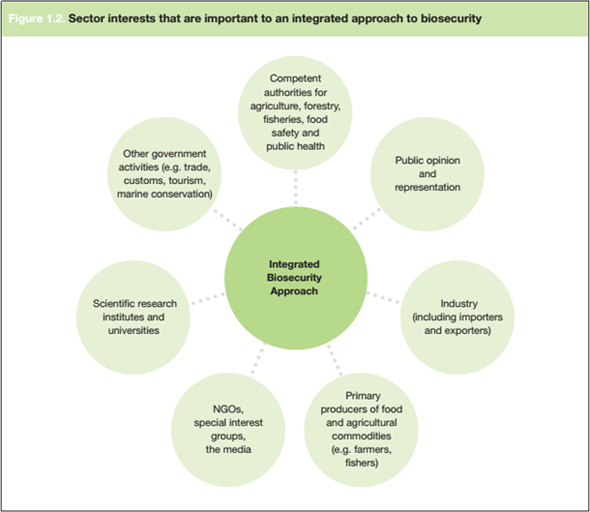
Better managing biosecurity issues with appropriate tools indeed considerably enhance the capability of countries to protect human health, agricultural production systems, and the people and industries that depend on them.
The FAO Toolkit comprises three parts:
The toolkit develops the thesis that risk analysis provides a common foundation for biosecurity but fully acknowledges that there is no universally acceptable or standard policy or infrastructure that should govern national biosecurity systems.
Human, animal and plant life, health and protection of the environment but also agriculture and health are inextricably linked in many ways. Biosecurity hazards of various types exist in each sector and have high potential to move between sectors. For example, many animal pathogens readily infect humans; animal feed may be contaminated with mycotoxins and plant toxins.
Changes in the environment, such as the loss of biological diversity and contamination of food and water sources, the size and scope of the global trade in animal feed and animal feed ingredients are examples of the immense potential for biosecurity hazards to move between and within countries.
Further, international events may superimpose requirements for more integrated and harmonized approaches. In particular, there is an increased recognition of the potential for wide-scale food-borne threats to public or animal health from acts of terrorism is a new consideration in modern biosecurity systems.
The merging of policies and values with science in biosecurity risk management presents considerable challenges and has different expression in different countries. As underlined in the FAO Toolkit, both risk assessment and risk management should thus be wrapped in a “sea of communication” that includes all stakeholders as appropriate.
Core decisions should involve the balancing of scientific findings against questions of life and health expectations, likely economic and social impacts, but also the technical feasibility and cost-effectiveness of controls. The increasing number and stringency of sanitary and phytosanitary requirements, the recognition of the high cost of regulation and acknowledgement of limited public resources are other drivers of these holistic changes. On top of this, there are increasing demands from industry for better cost-effectiveness of biosecurity systems and greater accommodation of new technologies.
Depending on the sector involved and as illustrated in the figure, there are various descriptions as to what constitutes a biosecurity hazard, All significant effects, positive and negative (hazards), should be systematically identified and their relative magnitudes considered in decision-making.
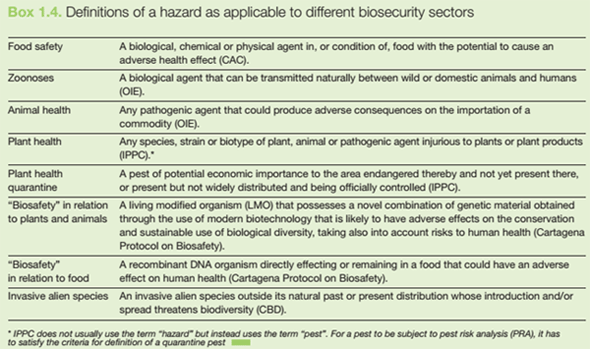
For food safety, biosecurity systems must identify and control hazards of biological, chemical and physical origin in imported food, food produced domestically and food that is exported.
For emerging zoonoses, defined as a biological agent that can be transmitted naturally between wild or domestic animals and humans, the convergence of biosecurity aspects of animal and human health is likely to lead to marked changes in the roles, partnerships and regulatory activities of competent authorities collectively involved in their control;
For animal health, over the last decades, there was a rapid expansion of consumption of animal products in developing countries, especially in Asia, with trade in animal commodities crossing borders very different, especially in terms of the volume, range and complexity of animal products. New and emerging diseases of animal health importance are increasing in incidence and geographical range.
Plant health can be adversely affected by different types of pests (i.e. plants themselves, and animals or pathogenic organisms which are injurious to plants or plant products). Establishment and spread of a pest often depend directly on biological factors such as availability of suitable plant hosts and vectors, crop cultivation practices, suitability of the environment and natural enemies.
Living Modified Organisms (LMOs) produced by modern biotechnology also may threaten the plant environment such as by out-crossing to create more aggressive weeds or wild relatives that upset the ecological balance and decrease biodiversity. While they may have potential benefits for human well-being and achieving sustainable economic development, their proliferation could have unintended adverse effects on the environment, including destruction of native flora and fauna, as well as adverse effects on human health. This could be especially significant in developing countries that do not have the capacity to track releases of these organisms and therefore cannot adequately safeguard national interests.
The Sanitary and Phytosanitary Measures of the World Trade Organisation (WTO SPS Agreement) states that in selecting measures to protect animal or plant health, governments shall take into account as relevant economic factors: costs of potential losses in production or sales, costs of control or eradication, and the relative cost-effectiveness of alternative measures. However, there is no consensus on how best to reflect socio-economic concerns and ecological risk assessment.
There are various descriptions in the different biosecurity sectors as to what constitutes a potential threat to health or life identified. Risk analysis processes are at the heart of contemporary approaches to biosecurity and the emergence of risk analysis as a unifying discipline in biosecurity underpins many of the changes in approach that are happening at the national level. These risk assessments have to be conducted on the basis of the hazard(s) identified to evaluate the probability and degree of exposure to them. Such biosecurity risk assessment management incorporates considerably different processes including a scientific process to estimate risks to life and health that may be associated with a particular food, animal, plant or specific organism. These are presented in the Part 1 of the Toolkit.
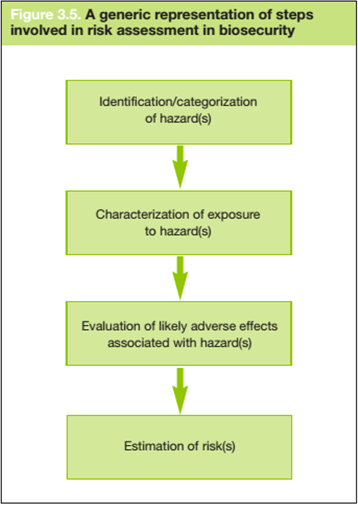
A prerequisite to facilitate the iterative and ongoing nature of risk analysis and for an effective risk management is that stringent efforts are made in risk communication to provide accurate and timely technical information about the risk from sources that are viewed as trustworthy, fair and unbiased3.
A particular need of a cross-sectoral approach to biosecurity is involvement in international communication networks and linkages. Formal and informal linkages and relationships greatly help governments to develop biosecurity strategies and establish control measures that are up-to-date and appropriate to the ever-changing global biosecurity environment. They give competent authorities early warning of the emergence or re-emergence of hazards in other parts of the globe (e.g. H5N1 avian influenza, BSE, Karnal bunt in wheat).
Utilization of the expertise and experience gained in all biosecurity situations has the potential to improve this risk analysis both within and between sectors, provides for consistency in approaches and outputs, and facilitates better uptake and understanding by competent authorities and other stakeholders.
3 To understand more clearly the essential differences between
the notions of hazard, risk and safety, watch the short animation
video![]()
The successful implementation of a harmonized and integrated biosecurity approach at national level requires a clear policy and legal framework, an institutional framework that defines the roles and responsibilities of relevant stakeholders, adequate technical and scientific capability (including use of risk analysis), a well-functioning infrastructure, and a system for communication and information exchange.
In the emerging globalized biosecurity environment, it is often more efficient to achieve biosecurity objectives at origin in exporting countries, rather than relying on controls at point-of-entry to the importing country. Implementing national biosecurity mandates demands human resources with adequate technical capability. This includes personnel with specialized scientific knowledge and skills to carry out biosecurity functions.
The complexity inherent in managing biosecurity requires communication and information exchange among a wide range of national stakeholders including government agencies, the private sector (agricultural producers, processors, enterprises, importers/exporters, etc.), the scientific and research community, and the general public.
In this context, a national biosecurity strategy under the responsibility of a single competent authority can provide an impetus and unifying force to support the achievement of a harmonized and integrated approach to biosecurity. Generally, an integrated approach is pursued by merging services and functions. Sector agencies can indeed better coordinate their work and actively seek to take advantage of the synergies and complementarities in their roles and responsibilities. This encompasses the joint setting of biosecurity priorities and allocation of resources, joint planning and implementation of activities, and integrated systems for monitoring and review of outcomes.
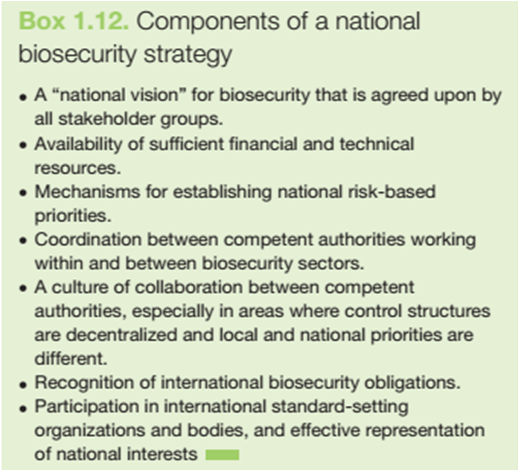
The FAO Toolkit examines critically the nature and performance of an existing biosecurity system, and describes first the needs for an integrated biosecurity approach:
It also describes the seven steps to assess biosecurity capacity needs:
Once these needs assessed, governments are better able to set priorities and organize their work, improve the use of available resources and raise additional resources for unmet needs.
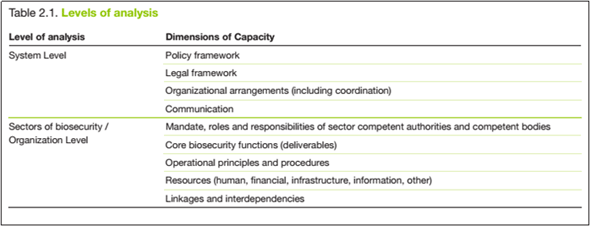
In step 3, a process to assess biosecurity capacity is illustrated. It provides a systematic and analytical means to critically examine the nature and performance of the existing biosecurity system, pinpoint areas for improvement and identify options to address these needs. At the sectoral/organizational level, the guide examines the capability of relevant competent authorities (in terms of their mandate, structure, processes, resources, infrastructure, etc.) to deliver core normative and technical functions of biosecurity based on a risk analysis approach.
The 3rd and 4d step in the capacity assessment process ask: what is the current situation of biosecurity capacity and performance? Understanding existing biosecurity capacity is indeed essential to be able to identify capacity needs accurately and to ensure that the needs identified and any capacity building activities subsequently developed fully reflect local circumstances.
Step 5 in the capacity assessment process is developing on this basis a shared vision of desired future biosecurity which is crucial to identifying capacity needs and actions to effectively respond to these needs through discussions and brainstorming sessions involving competent authorities and bodies. Some countries may decide to involve other groups (such as industry, academic or scientific institutes) given their contribution to biosecurity, for instance through compliance with regulations or their creation and provision of scientific knowledge.
The report highlights in particular the case of Norway or the one of New Zealand which has a high performing, integrated system for managing biosecurity risks to the economy, environment and human health underlining that “New Zealanders understand and have confidence in their biosecurity system, that they are committed and playing their vital role, from pre-border through to pest management”.
The steps 6 and 7 in the capacity assessment process focus on the diagnosis and analysis of needs and options to address them:
Step 6 focuses on the identification of capacity needs at the various interfaces between human, animal and plant life and health, and associated environmental protection, in terms of opportunities to take advantage of cross-sectoral synergies and/or to reduce overlaps. It will be important to differentiate between what is essential and what is simply desirable, and to prioritize the identified needs by focusing on the areas, resources and capabilities considered most important.
Step 7 seeks then to determine which actions and activities would be most effective to achieve the desired future situation in terms of expected biosecurity gains, costs and benefits, feasibility, affordability, legitimacy and timeliness.
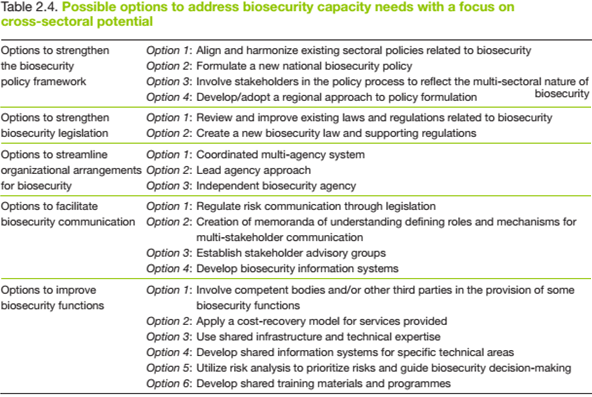
This manual presents a generic framework to structure and guide the application of risk analysis principles in biosecurity at the national level. The manual explores thus the processes and methods that are common to cross-sectoral biosecurity risk analysis and develops the position that coordinated action across sectors will inevitably result in improved outcomes and efficiencies. National governments are now paying an increasing attention to international legal instruments and standard-setting organizations to drive their better understanding of risk analysis. In this context, the Sanitary and Phytosanitary Measures of the World Trade Organisation (WTO SPS Agreement) has played a fundamental role in promoting the use of risk analysis and in establishing a solid framework for establishing legitimate health protection barriers among countries.
Also, risk assessments under the World Organisation for Animal Health (OIE) process designed to answer the question “What is the likelihood of specified adverse consequences occurring as a result of exposure to a particular commodity or pathogen that came from a defined release source?” are used. It underlines that biosecurity risk increases with increasing volume of the animal commodity imported but that no single method of import risk assessment is recommended for all situations.
In this context, performance indicators measuring the actual health and life outcomes required (e.g. expressed reduction in health risks over a particular time period) provide the “ultimate” measure of biosecurity performance. Where risk analysis has established a sufficient link between the “intermediate outcomes” and the actual health and life outcomes required other performance indicators measuring “intermediate outcomes” can provide an effective surrogate.
One of the scenarios considered is the improvement in biosecurity where, to achieve a common biosecurity goal, risk management gains are made in separate sectors.
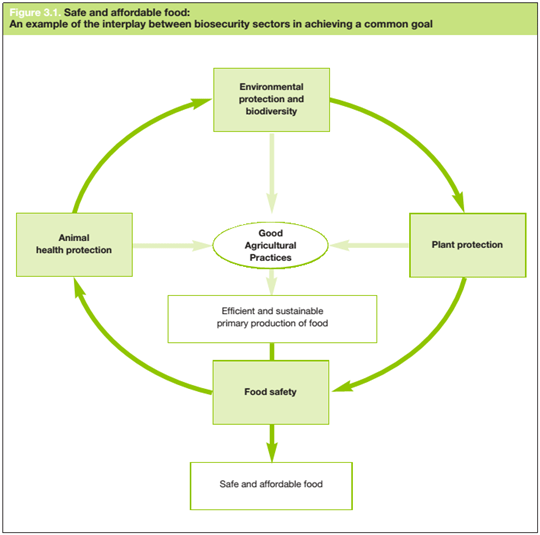
A SWOT analysis is a strategic planning tool that can be used to identify and assess strengths and weaknesses of biosecurity, as well as the opportunities and threats.
The process of conducting a SWOT helps to facilitate a common understanding of “reality” among a group of people. This makes it easier to understand and identify key capacity goals and needs, as well as possible solutions. An example SWOT analysis scenario for biosecurity is presented below.
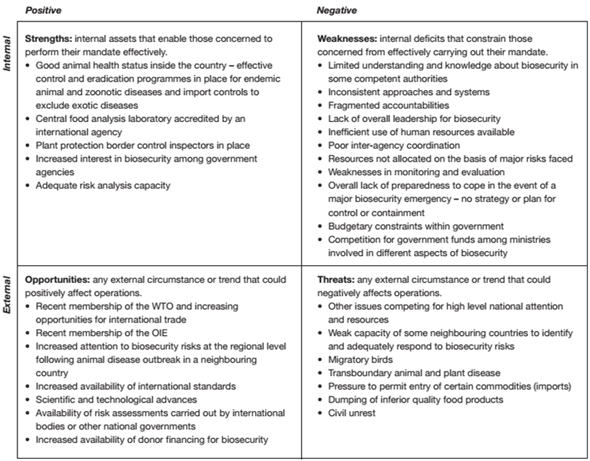
4 SWOT : Strengths-Weaknesses-Opportunities-Threats
Risk management in biosecurity can be described in general terms as the process of “weighing” control measure alternatives by government in consultation with interested stakeholders. This can be done by taking into account scientific information on risks to health and life and legitimate values-based inputs, and then choosing and implementing control measures as appropriate. Ranking and prioritization of biosecurity issues for risk management actions can then take place at different stages.
Basing control measures on risk assessment is an important biosecurity goal but the lack of available risk assessment models means that in the short term the majority of measures will be based on other scientific knowledge. Biosecurity decisions, standards and actions can be described as “hazard-based” when based on scientific knowledge of the likely level of reduction of hazards at a particular step in an exposure pathway. In the broadest sense, scientific information that is used as a basis for decision-making should be adequately evaluated as to its applicability to the particular biosecurity scenario in question.
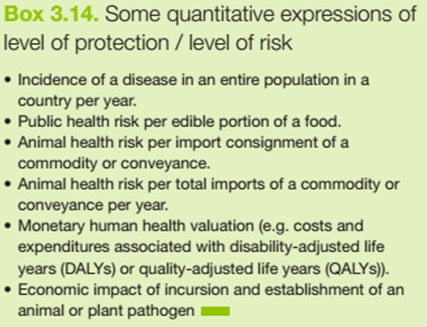
Issues will arise primarily from the ongoing activities of competent authorities such as inspection, monitoring of hazard exposure pathways, reviewing compliance records, surveillance, epidemiological studies, scientific research and market access negotiations.
Surveillance systems are often inaccurate in attributing adverse health effects in a population to a particular hazard exposure pathway, and in the case of import health standards for exotic hazards the level of protection is usually predicted rather than expressed. Therefore, where possible and practical, risk management will include a decision on an Appropriate Level Of Protection (ALOP) associated with a control measure or group of measures, range from the specific to the general, depending on the level of source attribution and other factors.
Since uncertainty is intrinsic to risk analysis, a precautionary approach is expressed in various ways during risk assessment and risk management. Precautionary positions may be intrinsic to risk assessment rules (e.g. use of safety factors in establishment of acceptable daily intakes) or may be introduced on a case-by-case basis (e.g. worst-case modelling scenarios). Precaution may also have qualitative expression, e.g. as labelling guidelines for foods derived from modern biotechnology that provide choice for government and consumer.
Optimization of control measures is an important principle and may involve a range of stakeholders in the implementation of measures at those steps in the hazard exposure pathway where risk reduction measures are most efficient and effective. The measures that are chosen by risk managers, such as quality assurance programmes administered by farmers, consumer education in safe food handling practices or public awareness and reporting of invasive alien species may not necessarily be mandatory.
In this context, a chapter of the 3rd manual describes a generic Risk Management Framework (RMF) that provides a simple four-step process to work through biosecurity issues as they arise at the national level.
With the increasing recognition that biosecurity is an interdependent partnership that requires participation from all biosecurity sectors at the international and national levels, significant benefits are now flowing from aligning approaches and sharing resources.
Identifying and managing the interplay of impacts between different sectors in adverse biosecurity situations is greatly improved when competent authorities work effectively together. Achieving better biosecurity outcomes in an efficient and cost-effective manner, especially in transitional and developing countries, is a significant challenge.
The emergence of risk analysis underpins many of the changes in approach that are happening within competent authorities around the world. It is predicted that administrative, structural and technical changes, together with cross-sectoral application of risk analysis principles, will greatly enhance the development of integrated biosecurity

This summary is free and ad-free, as is all of our content. You can help us remain free and independant as well as to develop new ways to communicate science by becoming a Patron!